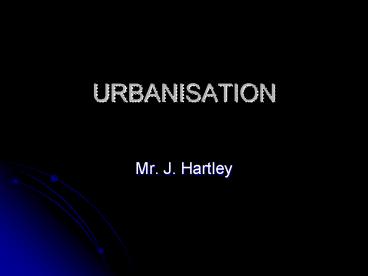URBANISATION - PowerPoint PPT Presentation
1 / 11
Title:
URBANISATION
Description:
... of work and entertainment. Better housing, services, (schools, hospitals, services, shopping facilities. ... Burgess based his model on the city of Chicago ... – PowerPoint PPT presentation
Number of Views:114
Avg rating:3.0/5.0
Title: URBANISATION
1
URBANISATION
- Mr. J. Hartley
2
What is URBANISATION?
- Urbanisation means an increase in the proportion
of people living in towns and cities. - Large scale urbanisation began In the early 19th
century in parts of Europe and North Eastern USA.
3
Reasons for URBANISATION.
- More and better paid jobs.
- Nearness to places of work and entertainment.
- Better housing, services, (schools, hospitals,
services, shopping facilities. - All of the above factors making the City more
appealing than the rural areas.
4
When and why were models produced?
- Models are used to try to explain something that
we can see in the physical environment.
During the 20th century a number of models were
developed to try to explain how urban areas grew.
Although models show a very general idea of the
shape of the city, most have aspects that can be
seen in most cities in the developed and
developing world.
5
Burgesss concentric ring model.
- You will need to locate this model in your text
book. - Burgess based his model on the city of Chicago
- At its core is the CBD, or Central Business
District. This is the area with the highest land
price, which could only be afforded by
businesses. - Also Known as Zone 1 or Zone B.
6
Burgesss concentric ring model.
- Around this is the zone of transition, which is
where industry located. In many cities in the UK,
such as Birmingham, this zone can be quite easily
identified. However in most cases the industry
has moved out, leaving the zone empty and in need
of renewal. - Also known as Zone 2 or Zone B.
- Beyond the zone of transition are the rings of
residential housing. As people became more
wealthy they could afford to live further out of
town, in bigger houses, with larger gardens.
7
Burgesss concentric ring model.
- Zone C (3) Lower class residential.
- Zone D (4) Middle class residential.
- Zone E (5) Higher class residential. Modern
Suburbia - The houses closest to the centre originally would
have housed the workers for the inner city
industries. Many British cities still have many
of these terraced houses remaining. - As people moved away from the CBD, the houses
closest to the centre would be taken by newly
arrived immigrants to the city, either from
elsewhere in the country or abroad.
8
Hoyts sector model.
- The sector model has a similar idea of a CBD to
Burgess? Look at your model. - This is still the area with the highest land
price. - Hoyt then used transport routes to determine
where his other sectors would be located. He
still had a zone of transition around the CBD,
but he also had industry fanning out from the
centre along major transport routes. He assumed
that like would attract like, which is why he
decided that land-uses would concentrate to form
sectors, rather being in rings, like Burgess
thought.
9
Hoyts sector model.
- The lowest class housing would be closest to the
industry, and probably be located where the
prevailing winds would blow the pollution towards
them (and away from the higher class housing). - The high class housing also is in a sector of its
own, running all the way from the CBD, where many
of the residents would work, to the outer
suburbs.
10
Types of Zones.
- Zone A (1) CBD central business district.
- Zone B (2) Zone of transition.
- Zone C (3) Residential (Lower Class).
- Zone D (4) Residential (Middle class).
- Zone E (5) Residential ( Upper Class).
- Zone F (6) Industry.
11
Urban Zoning
- Your task is to make notes on
- The CBD.
- The inner city.
- The suburbs.
- The rural-urban fringe.
- Use http//www.s-cool.co.uk/topic_quicklearn.asp
?locqltopic_id5quicklearn_id3subject_id20e
bt96ebnebseblelc4































